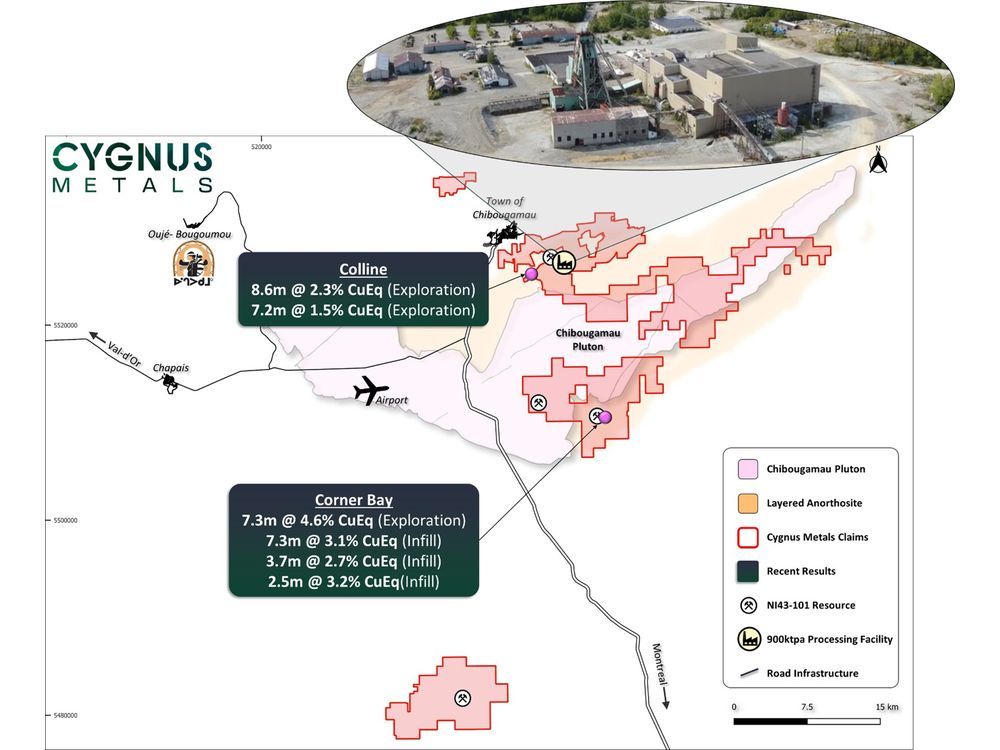
Author of the article:

Published Mar 17, 2025 • 35 minute read

Infill results of up to 5.6% CuEq highlight potential to increase indicated resource while exploration drilling at a new target delivers results such as 8.6m at 2.3% CuEq within 100m of surface, demonstrating scope for resource growth
Article content
Article content
TORONTO and PERTH, Western Australia, March 17, 2025 (GLOBE NEWSWIRE) —
HIGHLIGHTS:
- Cygnus’ strategy to create shareholder value by growing the overall Chibougamau Resources and upgrading more tonnes to Indicated category is delivering strong results
- Recent infill drilling results at the Corner Bay deposit have reconciled positively with the model. Significant intersections include:
- 7.3m @ 3.1% CuEq from 492.2m (2.7% Cu, 0.5g/t Au & 9.7g/t Ag) (CB-24-104),
- Including 3.3m @ 5.6% CuEq
- 7.3m @ 3.1% CuEq from 492.2m (2.7% Cu, 0.5g/t Au & 9.7g/t Ag) (CB-24-104),
- Corner Bay, which is the primary deposit at Chibougamau, has Indicated Mineral Resources of 2.7Mt at 2.9% CuEq and Inferred Mineral Resources of 5.9Mt at 3.6% CuEq1
- Corner Bay has also demonstrated resource growth potential with up to 9.7% CuEq intersected in Cygnus’ first drill hole of 7.3m @ 4.6% CuEq; This hole was outside the Corner Bay resource (see ASX release 23/01/25)
- At the new Colline target, recent exploration drilling intersected shallow mineralisation; First results include:
- 8.6m @ 2.3% CuEq from 95m (1.9% Cu, 0.3g/t Au & 19.0g/t Ag) (S3-25-002)
- Including 2.6m @ 4.4% CuEq and 2.2m @ 3.7% CuEq
- 8.6m @ 2.3% CuEq from 95m (1.9% Cu, 0.3g/t Au & 19.0g/t Ag) (S3-25-002)
- Colline was identified as a priority target through Cygnus’ ongoing review of historic drill logs with last drilling occurring in 1987; Significant historic drill intersections from Colline, dating back as far as the 1950s, include:
- 14.9m @ 2.9% CuEq from 157.3m (DQ-35);
- 9.1m @ 3.5% CuEq from 56.4m (S-19);
- 11.1m @ 4.4% CuEq from 109.0m (S-13); and
- 6.1m @ 3.2% CuEq from 95.4m (S3-84-2).
- Colline is completely outside existing mineral resources, sits less than 4km from the Chibougamau Processing Facility and highlights the potential to grow the high-grade Chibougamau Resource, comprised of Measured and Indicated Mineral Resources of 3.6Mt at 3.0% CuEq and Inferred Mineral Resources of 7.2Mt at 3.8% CuEq1
THIS CONTENT IS RESERVED FOR SUBSCRIBERS ONLY
Subscribe now to read the latest news in your city and across Canada.
- Exclusive articles from Barbara Shecter, Joe O'Connor, Gabriel Friedman, and others.
- Daily content from Financial Times, the world's leading global business publication.
- Unlimited online access to read articles from Financial Post, National Post and 15 news sites across Canada with one account.
- National Post ePaper, an electronic replica of the print edition to view on any device, share and comment on.
- Daily puzzles, including the New York Times Crossword.
SUBSCRIBE TO UNLOCK MORE ARTICLES
Subscribe now to read the latest news in your city and across Canada.
- Exclusive articles from Barbara Shecter, Joe O'Connor, Gabriel Friedman and others.
- Daily content from Financial Times, the world's leading global business publication.
- Unlimited online access to read articles from Financial Post, National Post and 15 news sites across Canada with one account.
- National Post ePaper, an electronic replica of the print edition to view on any device, share and comment on.
- Daily puzzles, including the New York Times Crossword.
REGISTER / SIGN IN TO UNLOCK MORE ARTICLES
Create an account or sign in to continue with your reading experience.
- Access articles from across Canada with one account.
- Share your thoughts and join the conversation in the comments.
- Enjoy additional articles per month.
- Get email updates from your favourite authors.
THIS ARTICLE IS FREE TO READ REGISTER TO UNLOCK.
Create an account or sign in to continue with your reading experience.
- Access articles from across Canada with one account
- Share your thoughts and join the conversation in the comments
- Enjoy additional articles per month
- Get email updates from your favourite authors
Sign In or Create an Account
or
Article content
______________________________
1 The Mineral Resource estimate at the Chibougamau Project is a foreign estimate prepared in accordance with CIM Standards and is not reported in accordance with the JORC Code. A competent person has not done sufficient work to classify the foreign estimate as a mineral resource in accordance with the JORC Code, and it is uncertain that following evaluation and/or further exploration work that the foreign estimate will be able to be reported as a mineral resource or ore reserve in accordance with the JORC Code.
The main Corner Bay deposit is demonstrating excellent continuity and grade as well as exploration upside, as shown by our earlier drilling results of up to 9.7% CuEq outside the resource.
Exploration has also delivered a new target with excellent results that are near-surface and within 4km of the 100 per cent-owned central processing facility.
The latest exploration results stem from the ongoing review of historic data, including drill logs that have not been looked at in over 30 years and never before in modern 3D software.
This makes it a highly efficient and effective way to establish new areas of mineralisation in this substantial mining camp. We look forward to uncovering more areas like Colline as part of our strategy to grow our high-grade copper-gold portfolio”.
Article content
Cygnus Metals Limited (ASX: CY5; TSXV: CYG, OTCQB: CYGGF) (“Cygnus” or the “Company”) is pleased to announce more strong drill results from both infill and exploration drilling as the Company executes its resource growth and conversion strategy at the Chibougamau Copper-Gold Project in Quebec, Canada.
Latest results from infill drilling at Corner Bay include intervals of up to 5.6% CuEq and point to an updated resource classification. This is in addition to resource growth opportunities with up to 9.7% CuEq intersected in Cygnus’ first drill hole returned from outside the Corner Bay resource (see ASX release dated 23 January 2025).
Ongoing exploration drilling has also returned significant results from a new target area called Colline, with high grade results, some of which are less than 100m from surface. Results include up to 8.6m @ 2.3% CuEq from 95m with higher grade including intervals of 2.6m @ 4.4% CuEq and 2.2m @ 3.7% CuEq. Colline is located within 4km of the 100% owned central processing facility.
Drilling with two rigs is ongoing while follow up downhole electromagnetics (DHEM) is being utilised to define follow up targets.
By signing up you consent to receive the above newsletter from Postmedia Network Inc.
Article content
Article content
About Infill Drilling Results at Corner Bay
Drilling at Corner Bay is targeting both resource conversion and resource growth opportunities. Recent results from Corner Bay are from infill drilling that targeted the southern extent of the upper main vein. Significant results from this drilling include:
- 7.3m @ 3.1% CuEq from 492.2m (2.7% Cu, 0.5g/t Au and 9.7g/t Ag) (CB-24-104);
- Including 3.3m @ 5.6% CuEq
- 3.7m @ 2.7% CuEq from 390.4m (2.5% Cu, 0.2g/t Au and 8.5g/t Ag) (CB-24-105);
- Including 1.8m @ 3.3% CuEq and
- 2.5m @ 3.2% CuEq from 572.5m (3.0% Cu, 0.1g/t Au and 10.9g/t Ag) (CB-24-103)
- Including 1.2m @ 5.0% CuEq
Overall results have reconciled positively against the block model as well as improving an area of lower grade. These results and ongoing drilling highlight the potential to update the resource classification alongside increasing the global resource through exploration drilling.
Exploration upside was highlighted with the previously released first hole of the program (CB-24-100) intersecting a potential new subparallel lode with a high-grade drill result of 7.3m @ 4.6% CuEq (4.2% Cu, 0.3g/t Au & 16.6g/t Ag) from 317.1m, which includes 2.5m @ 9.7% CuEq (9.1% Cu, 0.5g/t Au & 31.4g/t Ag). Drilling at Corner Bay is ongoing executing this dual track growth strategy.
Article content

Figure 1: Location of Corner Bay recent drill results and new target ‘Colline’ just 4km from the central Processing Facility with results of up to 8.6m @ 2.3% CuEq, less than 100m from surface.
About the Exploration Drilling Results at Colline
Colline was identified as a priority target at the Chibougamau Project with near-surface mineralisation identified during the ongoing review of historic hardcopy drill logs going back as far as the 1950s.2 The last time the area was drilled was in 1987, when copper prices were substantially less than today. Historically significant drill intersections include (refer Appendix C and ASX release dated 15 October 2024):
- 14.9m @ 2.9% CuEq from 157.3m (DQ-35);
- 9.1m @ 3.5% CuEq from 56.4m (S-19);
- 11.1m @ 4.4% CuEq from 109.0m (S-13); and
- 6.1m @ 3.2% CuEq from 95.4m (S3-84-2).
The Colline area has never been mined and is outside the current Mineral Resources, presenting an opportunity for potential near-surface resource growth within 4km of the 100%-owned Chibougamau Processing Facility.
Cygnus recently completed a small, targeted drilling program aiming to confirm and extend at depth the historic mineralisation while also providing a platform for follow up DHEM. Results received to date from this program include the following significant intersections:
Article content
- 8.6m @ 2.3% CuEq from 95m (1.9% Cu, 0.3g/t Au,& 19.0g/t Ag) (S3-25-002)
- Including 2.6m @ 4.4% CuEq & 2.2m @ 3.7% CuEq
- 7.2m @ 1.5% CuEq from 269.4m (1.3% Cu, 0.2g/t Au & 6.7g/t Ag) (S3-25-005)
- Including 2.0m @ 2.6% CuEq
These results confirm mineralisation to a depth of 250m below surface, remaining open, with assays pending for the remaining holes of the program. DHEM will now be applied to confirm further potential extensions at depth and provide follow up drill targets.
Ongoing Drilling
In line with the Company’s growth strategy, drilling is continuing with two diamond drill rigs. This initial program is focussing on resource growth and conversion opportunities surrounding some of the existing deposits as well as brownfield exploration opportunities, aiming to build upon the existing high-grade mineral resources. The Company looks forward to a high volume of news flow during 2025 with ongoing drilling updates and results.

Figure 2: Results from Colline less than 100m from surface, with up to 8.6m @ 2.3% CuEq (refer Appendix B). Refer to Appendix C and ASX release dated 15 October 2024 for previously announced drilling results.
Article content
This announcement has been authorised for release by the Board of Directors of Cygnus.
About Cygnus Metals
Cygnus Metals Limited (ASX: CY5, TSXV: CYG, OTCQB: CYGGF) is a diversified critical minerals exploration and development company with projects in Quebec, Canada and Western Australia. The Company is dedicated to advancing its Chibougamau Copper-Gold Project in Quebec with an aggressive exploration program to drive resource growth and develop a hub-and-spoke operation model with its centralised processing facility. In addition, Cygnus has quality lithium assets with significant exploration upside in the world-class James Bay district in Quebec, and REE and base metal projects in Western Australia. The Cygnus team has a proven track record of turning exploration success into production enterprises and creating shareholder value.
Article content
Neither TSX Venture Exchange nor its Regulation Services Provider (as that term is defined in policies of the TSX Venture Exchange) accepts responsibility for the adequacy or accuracy of this release.
Forward Looking Statements
This release may contain certain forward-looking statements and projections regarding estimates, resources and reserves; planned production and operating costs profiles; planned capital requirements; and planned strategies and corporate objectives. Such forward looking statements/projections are estimates for discussion purposes only and should not be relied upon. They are not guarantees of future performance and involve known and unknown risks, uncertainties and other factors, many of which are beyond Cygnus’ control. Cygnus makes no representations and provides no warranties concerning the accuracy of the projections and disclaims any obligation to update or revise any forward-looking statements/projects based on new information, future events or otherwise except to the extent required by applicable laws. While the information contained in this release has been prepared in good faith, neither Cygnus or any of its directors, officers, agents, employees or advisors give any representation or warranty, express or implied, as to the fairness, accuracy, completeness or correctness of the information, opinions and conclusions contained in this release. Accordingly, to the maximum extent permitted by law, none of Cygnus, its directors, employees or agents, advisers, nor any other person accepts any liability whether direct or indirect, express or limited, contractual, tortuous, statutory or otherwise, in respect of the accuracy or completeness of the information or for any of the opinions contained in this release or for any errors, omissions or misstatements or for any loss, howsoever arising, from the use of this release.
Article content
End Notes
- The Mineral Resource estimate at the Chibougamau Project is a foreign estimate prepared in accordance with CIM Standards. A competent person has not done sufficient work to classify the foreign estimate as a mineral resource in accordance with the JORC Code, and it is uncertain whether further evaluation and exploration will result in an estimate reportable under the JORC Code. Refer to Appendix D for a breakdown of the Mineral Resource Estimate.
- Sources for historical drilling at Colline: Diamond Drill Record. GM 00640-B, 1950. 75 pages and 13 plans by Dallaire, J.R.; Diamond Drill Sampling Record. GM 00971, 1952. 391 pages and 1 plan by Dallaire, J.R.; Journaux de Sondage au Diamant, Mines Northgate Inc. GM 46635, 1988. 116 pages and 2 plans by Gervais, D., Larouche, V., Blais, A., and Larouche, C.
Qualified Persons and Compliance Statements
The scientific and technical information in this announcement has been reviewed and approved by Mr Louis Beaupre, the Quebec Exploration Manager of Cygnus, a “qualified person” as defined in National Instrument 43-101 – Standards of Disclosure for Mineral Projects. The Exploration Results disclosed in this announcement are also based on and fairly represent information and supporting documentation compiled by Mr Beaupre. Mr Beaupre holds options in Cygnus. Mr Beaupre is a member of the Ordre des ingenieurs du Quebec (P. Eng.), a Registered Overseas Professional Organisation as defined in the ASX Listing Rules, and has sufficient experience which is relevant to the style of mineralisation and type of deposits under consideration and to the activity which has been undertaken to qualify as a Competent Person as defined in the 2012 Edition of the “Australasian Code for Reporting of Exploration Results, Mineral Resources and Ore Reserves”. Mr Beaupre consents to the inclusion in this release of the matters based on the information in the form and context in which they appear.
Article content
The Company first announced the foreign estimate of mineralisation for the Chibougamau Project on 15 October 2024. The Company confirms that the supporting information included in the original announcement continues to apply and has not materially changed, notwithstanding the clarification announcement released by Cygnus on 28 January 2025 (“Clarification”). Cygnus confirms that (notwithstanding the Clarification) it is not aware of any new information or data that materially affects the information included in the original announcement and that all material assumptions and technical parameters underpinning the estimates in the original announcement continue to apply and have not materially changed. Cygnus confirms that it is not in possession of any new information or data that materially impacts on the reliability of the estimates or Cygnus’ ability to verify the foreign estimates as mineral resources in accordance with the JORC Code. The Company confirms that the form and context in which the Competent Persons’ findings are presented have not been materially modified from the original market announcement.
Article content
The information in this announcement that relates to previously reported Exploration Results at the Company’s projects has been previously released by Cygnus in ASX Announcements as noted in the text. Cygnus is not aware of any new information or data that materially affects the information in these announcements. The Company confirms that the form and context in which the Competent Persons’ findings are presented have not been materially modified from the original market announcements.
Individual grades for the metals included in the metal equivalents calculation for the foreign estimate are in Appendix D of this release. Metal equivalents for the foreign estimate of mineralisation have been calculated at a copper price of US$8,750/t, gold price of US$2,350/oz, with copper equivalents calculated based on the formula CuEq (%) = Cu(%) + (Au (g/t) x 0.77258). Individual grades for the metals included in the metal equivalents calculation for the exploration results are in Appendices A, B and C of this release. Metal equivalents for exploration results have been calculated at a copper price of US$8,750/t, gold price of US$2,350/oz and silver price of US$25/oz, with copper equivalents calculated based on the formula CuEq(%) = Cu(%) + (Au(g/t) x 0.77258)+(Ag(g/t) x 0.00822). Metallurgical recovery factors have been applied to the copper equivalents calculations, with copper metallurgical recovery assumed at 95% and precious metal (gold and silver) metallurgical recovery assumed at 85% based upon historical production at the Chibougamau Processing Facility, and the metallurgical results contained in Cygnus’ announcement dated 28 January 2025. It is the Company’s view that all elements in the copper equivalent calculations in respect of the foreign estimate and exploration results have a reasonable potential to be recovered and sold.
Article content
APPENDIX A – Significant Intersections from Recent Infill Drilling at Corner Bay
Coordinates given in UTM NAD83 (Zone 18). Intercept lengths may not add up due to rounding to appropriate reporting precision. Significant intersections to date reported above 1% Cu or 0.5g/t Au over widths of greater than 1m. True width estimated to be between 60-75% of downhole intersection.
| Hole ID | X | Y | Z | Azi | Dip | Depth (m) | From (m) | To (m) | Interval (m) | Cu (%) | Au (g/t) | Ag (g/t) | CuEq (%) |
| CB-24-103 | 554721 | 5509893 | 398 | 115 | -67 | 597 | 494.3 | 495.9 | 1.6 | 1.9 | 0.4 | 22.3 | 2.3 |
| and | 572.5 | 574.9 | 2.5 | 3.0 | 0.1 | 10.9 | 3.2 | ||||||
| including | 573.0 | 574.2 | 1.2 | 4.8 | 0.1 | 15.6 | 5.0 | ||||||
| CB-24-104 | 554722 | 5509892 | 398 | 85 | -69 | 603 | 492.2 | 499.5 | 7.3 | 2.7 | 0.5 | 9.7 | 3.1 |
| including | 493.0 | 496.3 | 3.3 | 4.7 | 1.0 | 18.3 | 5.6 | ||||||
| CB-24-105 | 554726 | 5509910 | 398 | 103 | -57 | 492 | 390.4 | 394.0 | 3.7 | 2.5 | 0.2 | 8.5 | 2.7 |
| including | 390.4 | 392.1 | 1.8 | 3.1 | 0.2 | 11.2 | 3.3 | ||||||
| CB-24-106 | 554726 | 5509910 | 398 | 94 | -63 | 540 | 412.5 | 414.4 | 1.9 | 0.1 | 2.0 | 6.8 | 2.1 |
| and | 421.4 | 423.0 | 1.7 | 2.7 | 0.3 | 8.7 | 3.0 |
APPENDIX B – Significant Intersections from Recent Exploration Drilling at Colline
Coordinates given in UTM NAD83 (Zone 18). Intercept lengths may not add up due to rounding to appropriate reporting precision. Significant intersections to date reported above 1% Cu or 0.5g/t Au over widths of greater than 1m. Cygnus has completed nine (9) holes totalling 2,896m. True width estimated to be 80% of downhole intersection.
Article content
| Hole ID | X | Y | Z | Azi | Dip | Depth (m) | From (m) | To (m) | Interval (m) | Cu (%) | Au (g/t) | Ag (g/t) | CuEq (%) |
| S3-25-001 | 548851 | 5524583 | 368 | 50 | -50 | 303.0 | Pending Results | ||||||
| S3-25-002 | 548851 | 5524583 | 379 | 20 | -50 | 207.0 | 95.0 | 103.6 | 8.6 | 1.9 | 0.3 | 19.0 | 2.3 |
| including | 95.0 | 97.2 | 2.2 | 3.0 | 0.6 | 29.5 | 3.7 | ||||||
| including | 101.0 | 103.6 | 2.6 | 3.6 | 0.7 | 36.0 | 4.4 | ||||||
| S3-25-003 | 548710 | 5524764 | 387 | 230 | -50 | 252.0 | Pending Results | ||||||
| S3-25-004 | 548637 | 5524737 | 381 | 240 | -50 | 210.0 | Pending Results | ||||||
| S3-25-005 | 548715 | 5524554 | 415 | 51 | -53 | 354.8 | 269.4 | 276.6 | 7.2 | 1.3 | 0.2 | 6.7 | 1.5 |
| including | 273.6 | 275.6 | 2.0 | 2.4 | 0.1 | 12.5 | 2.6 | ||||||
| S3-25-006 | 548715 | 5524554 | 415 | 50.5 | -63 | 495.0 | Pending Results | ||||||
| S3-25-007 | 548736 | 5524522 | 400 | 47 | -51.5 | 381.0 | |||||||
| S3-25-008 | 548736 | 5524522 | 400 | 47 | -55 | 366.0 | |||||||
| S3-25-009 | 549197 | 5524377 | 399 | 50 | -50 | 327.0 | |||||||
APPENDIX C – Significant Intersections from Historic Drilling at Colline
Coordinates given in UTM NAD83 (Zone 18). Intercept lengths may not add up due to rounding to the appropriate reporting precision. Significant intersections reported above 1% copper or 0.5g/t gold over widths of greater than 1m.
| Year | Hole ID | X | Y | Z | Azi | Dip | Depth (m) | From (m) | To (m) | Interval (m) | Cu (%) | Au (g/t) | Ag (g/t) | CuEq (%) |
| 1955 | DQ-35 | 548883 | 5524691 | 380 | 230 | -75 | 184 | 157.3 | 172.2 | 14.9 | 1.5 | 1.8 | 0.1 | 2.9 |
| 1984 | S3-84-2 | 548838 | 5524597 | 380 | 19 | -59 | 108 | 95.4 | 101.5 | 6.1 | 0.5 | 3.5 | 0.0 | 3.2 |
| 1950 | S-21 | 548884 | 5524690 | 376 | 193 | -60 | 137 | 96.2 | 104.7 | 8.5 | 0.3 | 1.8 | 1.0 | 1.7 |
| 1955 | DQ-26 | 548828 | 5524752 | 380 | 230 | -58 | 158 | 117.3 | 130.4 | 13.1 | 0.1 | 0.9 | 0.1 | 0.9 |
| 1950 | S-27 | 548851 | 5524574 | 376 | 15 | -58 | 222 | 119.0 | 127.7 | 8.7 | 0.0 | 1.6 | 1.7 | 1.3 |
| 1955 | DQ-32 | 548869 | 5524721 | 380 | 230 | -44 | 115 | 101.5 | 109.4 | 7.9 | 0.1 | 1.5 | 0.5 | 1.3 |
| 1955 | DQ-30 | 548869 | 5524735 | 380 | 230 | -61 | 141 | 117.0 | 121.6 | 4.6 | 0.2 | 2.6 | 0.1 | 2.2 |
| 1984 | S3-84-5 | 548967 | 5524415 | 380 | 2 | -60 | 231 | 207.0 | 214.0 | 7.0 | 1.0 | 0.2 | 0.8 | 1.2 |
| 1950 | DQ-4 | 548892 | 5524674 | 376 | 127 | -73 | 169 | 105.8 | 109.0 | 3.2 | 0.3 | 2.8 | 1.1 | 2.5 |
| 1950 | S-22 | 548884 | 5524690 | 376 | 233 | -68 | 126 | 105.6 | 110.3 | 4.7 | 0.1 | 1.9 | 1.4 | 1.5 |
| 1950 | S-10 | 548874 | 5524672 | 376 | 235 | -45 | 78 | 64.0 | 67.1 | 3.0 | 0.6 | 1.7 | 0.3 | 1.9 |
| 1950 | S-11 | 548815 | 5524707 | 379 | 210 | -45 | 63 | 45.7 | 48.8 | 3.0 | 0.2 | 1.9 | 1.2 | 1.7 |
| 1955 | DQ-33 | 548887 | 5524737 | 380 | 230 | -68 | 211 | 181.7 | 184.7 | 3.0 | 0.0 | 1.0 | 0.5 | 1.1 |
| 1955 | DQ-31 | 548876 | 5524685 | 380 | 230 | -58 | 115 | 78.3 | 81.4 | 3.1 | 0.0 | 1.3 | 0.8 | 1.0 |
| 1950 | S-23 | 548862 | 5524715 | 378 | 233 | -70 | 154 | 134.1 | 137.2 | 3.0 | 0.0 | 1.3 | 0.0 | 1.0 |
| 1955 | DQ-29 | 548867 | 5524677 | 380 | 230 | -47 | 86 | 65.8 | 67.4 | 1.6 | 0.0 | 2.4 | 0.3 | 1.9 |
| 1986 | S3-86-5 | 548867 | 5524773 | 378 | 200 | -50 | 220 | 148.1 | 149.8 | 1.8 | 0.1 | 1.9 | 0.0 | 1.6 |
Article content
APPENDIX D – Chibougamau Copper-Gold Project – Foreign Mineral Resource Estimate Disclosures as at 30 March 2022
| Deposit | Category | Tonnes (k) | Cu Grade (%) | Au Grade (g/t) | Cu Metal (kt) | Au Metal (koz) | CuEq Grade (%) |
| Corner Bay (2022) | Indicated | 2,700 | 2.7 | 0.3 | 71 | 22 | 2.9 |
| Inferred | 5,900 | 3.4 | 0.3 | 201 | 51 | 3.6 | |
| Devlin (2022) | Measured | 120 | 2.7 | 0.3 | 3 | 1 | 2.9 |
| Indicated | 660 | 2.1 | 0.2 | 14 | 4 | 2.3 | |
| Measured & Indicated | 780 | 2.2 | 0.2 | 17 | 5 | 2.4 | |
| Inferred | 480 | 1.8 | 0.2 | 9 | 3 | 2.0 | |
| Joe Mann (2022) | Inferred | 610 | 0.2 | 6.8 | 1 | 133 | 5.5 |
| Cedar Bay (2018) | Indicated | 130 | 1.6 | 9.4 | 2 | 39 | 8.9 |
| Inferred | 230 | 2.1 | 8.3 | 5 | 61 | 8.5 | |
| Total | Measured & Indicated | 3,600 | 2.5 | 0.6 | 90 | 66 | 3.0 |
| Inferred | 7,200 | 3.0 | 1.1 | 216 | 248 | 3.8 |
APPENDIX E – 2012 JORC Table 1
Section 1 Sampling Techniques and Data
| Criteria | JORC Code explanation | Commentary |
| Sampling techniques | Nature and quality of sampling (eg cut channels, random chips, or specific specialised industry standard measurement tools appropriate to the minerals under investigation, such as down hole gamma sondes, or handheld XRF instruments, etc). These examples should not be taken as limiting the broad meaning of sampling. |
|
| Include reference to measures taken to ensure sample representivity and the appropriate calibration of any measurement tools or systems used. |
| |
| Aspects of the determination of mineralisation that are Material to the Public Report. In cases where ‘industry standard’ work has been done this would be relatively simple (eg ‘reverse circulation drilling was used to obtain 1 m samples from which 3 kg was pulverised to produce a 30 g charge for fire assay’). In other cases more explanation may be required, such as where there is coarse gold that has inherent sampling problems. Unusual commodities or mineralisation types (eg submarine nodules) may warrant disclosure of detailed information. |
| |
| Drilling techniques | Drill type (eg core, reverse circulation, open-hole hammer, rotary air blast, auger, Bangka, sonic, etc) and details (eg core diameter, triple or standard tube, depth of diamond tails, face-sampling bit or other type, whether core is oriented and if so, by what method, etc). |
|
| Drill sample recovery | Method of recording and assessing core and chip sample recoveries and results assessed. Measures taken to maximise sample recovery and ensure representative nature of the samples. Whether a relationship exists between sample recovery and grade and whether sample bias may have occurred due to preferential loss/gain of fine/coarse material. |
|
| Logging | Whether core and chip samples have been geologically and geotechnically logged to a level of detail to support appropriate Mineral Resource estimation, mining studies and metallurgical studies. |
|
| Whether logging is qualitative or quantitative in nature. Core (or costean, channel, etc) photography. |
| |
| The total length and percentage of the relevant intersections logged. |
| |
| Sub-sampling techniques and sample preparation | If core, whether cut or sawn and whether quarter, half or all core taken. If non-core, whether riffled, tube sampled, rotary split, etc and whether sampled wet or dry. For all sample types, the nature, quality and appropriateness of the sample preparation technique. Quality control procedures adopted for all sub-sampling stages to maximise representivity of samples. Measures taken to ensure that the sampling is representative of the in-situ material collected, including for instance results for field duplicate/second-half sampling. Whether sample sizes are appropriate to the grain size of the material being sampled. |
|
| Quality of assay data and laboratory tests | The nature, quality and appropriateness of the assaying and laboratory procedures used and whether the technique is considered partial or total. |
|
| For geophysical tools, spectrometers, handheld XRF instruments, etc, the parameters used in determining the analysis including instrument make and model, reading times, calibrations factors applied and their derivation, etc. |
| |
| Nature of quality control procedures adopted (eg standards, blanks, duplicates, external laboratory checks) and whether acceptable levels of accuracy (i.e. lack of bias) and precision have been established. |
| |
| Verification of sampling and assaying | The verification of significant intersections by either independent or alternative company personnel. |
|
| The use of twinned holes. |
| |
| Documentation of primary data, data entry procedures, data verification, data storage (physical and electronic) protocols. |
| |
| Discuss any adjustment to assay data. |
| |
| Location of data points | Accuracy and quality of surveys used to locate drill holes (collar and down-hole surveys), trenches, mine workings and other locations used in Mineral Resource estimation. |
|
| Specification of the grid system used. |
| |
| Quality and adequacy of topographic control. |
| |
| Data spacing and distribution | Data spacing for reporting of Exploration Results. |
|
| Whether the data spacing and distribution is sufficient to establish the degree of geological and grade continuity appropriate for the Mineral Resource and Ore Reserve estimation procedure(s) and classifications applied. |
| |
| Whether sample compositing has been applied. |
| |
| Orientation of data in relation to geological structure | Whether the orientation of sampling achieves unbiased sampling of possible structures and the extent to which this is known, considering the deposit type. |
|
| If the relationship between the drilling orientation and the orientation of key mineralised structures is considered to have introduced a sampling bias, this should be assessed and reported if material. |
| |
| Sample security | The measures taken to ensure sample security. |
|
| Audits or reviews | The results of any audits or reviews of sampling techniques and data. |
|
Article content
Section 2 Reporting of Exploration Results
(Criteria listed in the preceding section also apply to this section.)
| Criteria | JORC Code Explanation | Commentary |
| Mineral tenement and land tenure status | Type, reference name/number, location and ownership including agreements or material issues with third parties such as joint ventures, partnerships, overriding royalties, native title interests, historical sites, wilderness or national park and environmental settings. |
|
| The security of the tenure held at the time of reporting along with any known impediments to obtaining a licence to operate in the area. |
| |
| Exploration done by other parties | Acknowledgment and appraisal of exploration by other parties. |
|










